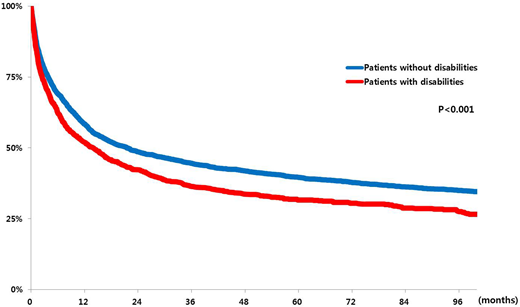Abstract
Introduction
Acute leukemia is a fatal hematologic malignancy. Because the clinical features of patients with acute leukemia can deteriorate very quickly, an early diagnosis and appropriate treatment are important for these patients.
People with disabilities tend to be physically and mentally vulnerable and often have serious economic issues as well. Such situations can be linked to suboptimal diagnoses and treatments in case of acute leukemia. The purpose of this study is to analyze diagnosis rates, treatment patterns and prognoses of acute leukemia patients with disabilities and compare these findings with those of patients without disabilities.
Method
The major data sources were the National Disability Database, the Korean Central Cancer Registry, and the Korean National Health Insurance claim database. We built a cohort of 2,776,450 people with disabilities from the Korean National Disability Database. To establish a non-disabled cohort of 8,329,350 as a comparative group, frequency-matched sampling with the disabled group was performed using a merged database, with individuals grouped by age and sex at a ratio of 1:3. From this population, adult patients who were diagnosed with acute myeloid or lymphoblastic leukemia were selected for analysis. Disabilities were categorized into the following types: physical, communication, and intellectual/psychological.
Results
Among the 8,329,350 people without disabilities and 2,776,450 with disabilities, 3,171 and 873 were diagnosed with acute leukemia, respectively. The prevalence rates of acute leukemia were 38.07 per 100,000 without disabilities and 31.44 per 100,000 with disabilities. Among the acute leukemia patients with disabilities, those in the lowest income group amounted to 13.4% of the total, which was significantly higher than the rate of 4.3% of the patients without disabilities (P < 0.0001). When analyzed by disability type, the numbers of patients with intellectual/psychological disability (50.37 per 100,000) and a communication disability (31.93 per 100,000) was exceeded the number of those with a physical disability (28.34 per 100,000).
Chemotherapy for acute leukemia was performed in 61.7% of patients with disabilities, which was significantly lower than the rate of 68.0% for acute leukemia patients without a disability (p = 0.0006). Patients with communication (53.7%) or intellectual/psychological disabilities (54.2%) received chemotherapy less often than those with a physical disability (68.6%). Allogeneic hematopoietic stem cell transplantation was performed in 11.2% of patients without a disability and 8.0% of disabled patients (p = 0.0026). The number of hospitalization days per patient during the first year after diagnosis was 109.3 days for the disabled and 126.1 days for the non - disabled (P <0.0001).
The median survival was 14.0 months for patients with disabilities, which was significantly shorter than those without a disability (21.4 months) (P <0.0001). Patients with a communication disorder (8.1 months) and an intellectual/psychological disability (13.1 months) had significantly worse survival rates than patients with a physical disability (15.2 months) (P < 0.0001).
Conclusion
People with disabilities overall have a relatively low diagnosis rate of acute leukemia and undergo less active treatment of acute leukemia. This tendency is particularly evident in patients with intellectual/psychological and communication disabilities. Patients with acute leukemia with disabilities have significantly lower survival rates than those without a disability. Various measures including financial support are needed to ensure that acute leukemia patients with disabilities receive appropriate treatment and achieve long-term survival.
No relevant conflicts of interest to declare.
Author notes
Asterisk with author names denotes non-ASH members.


